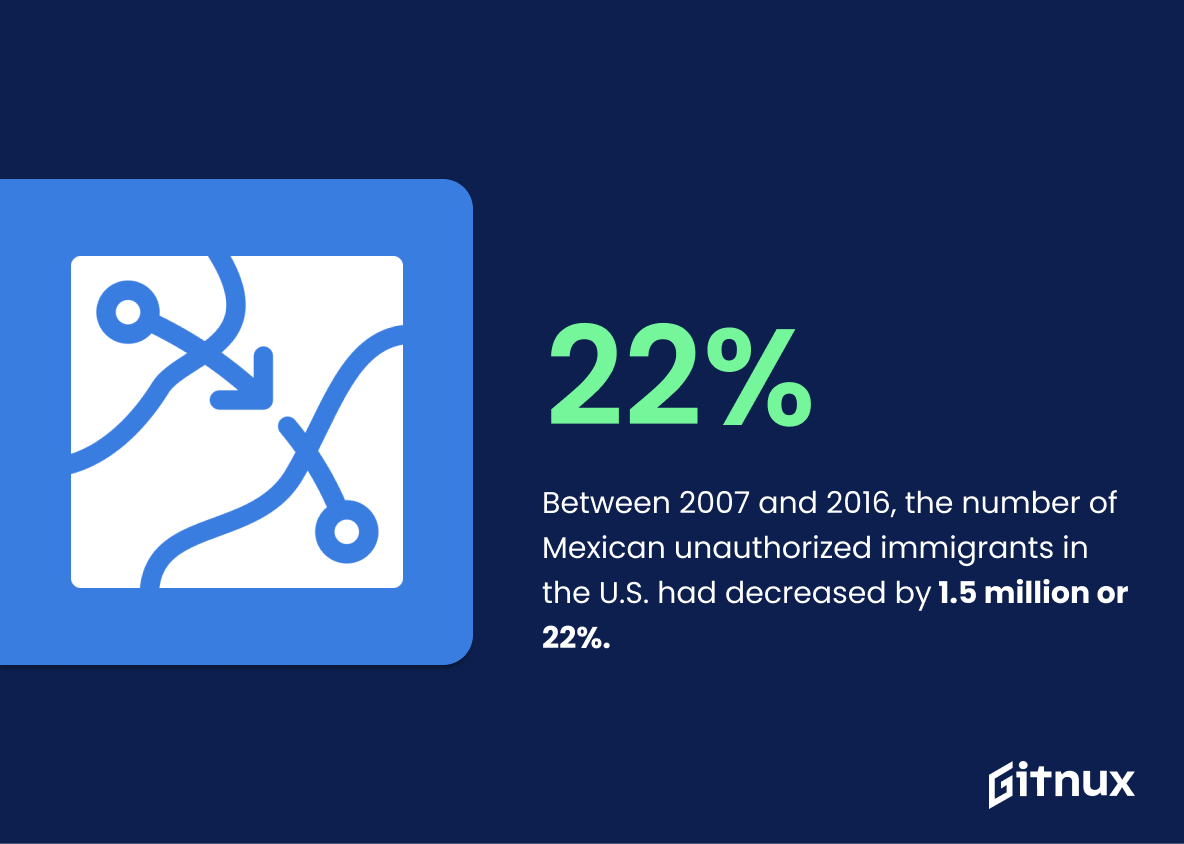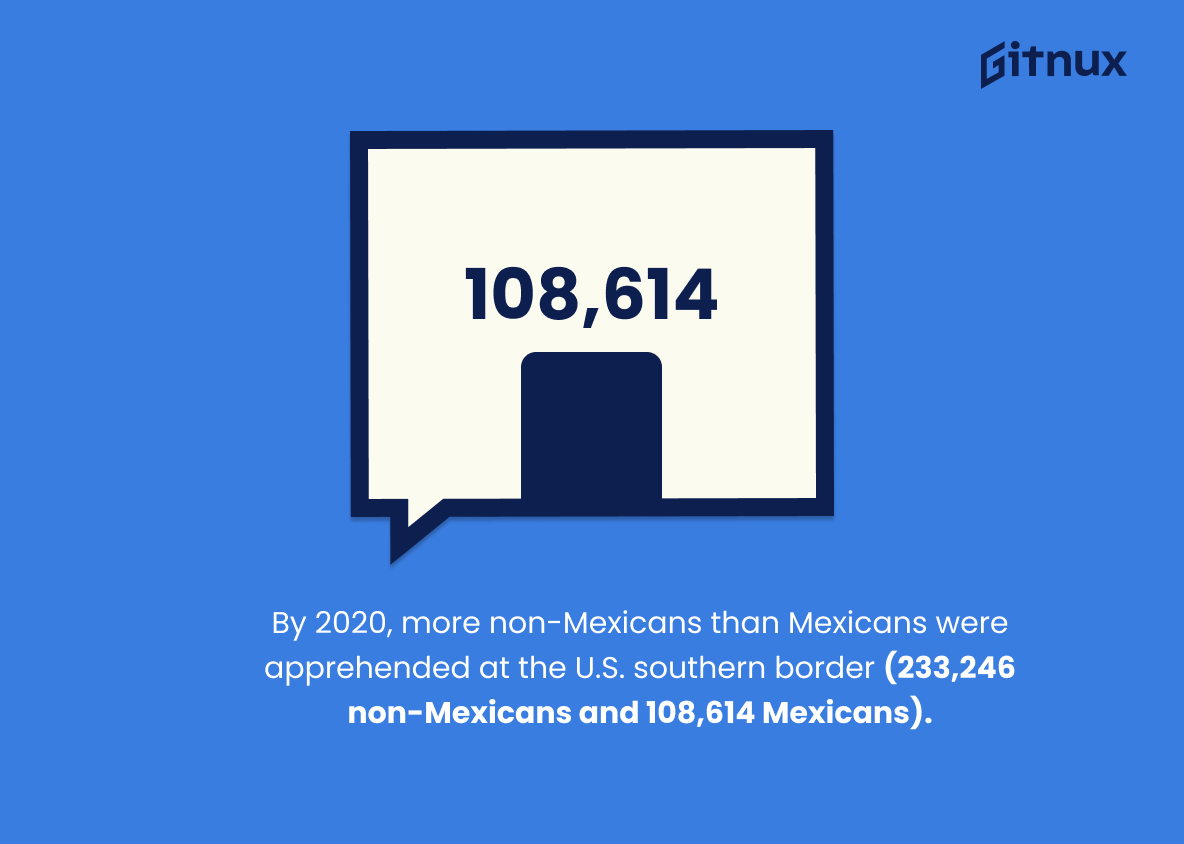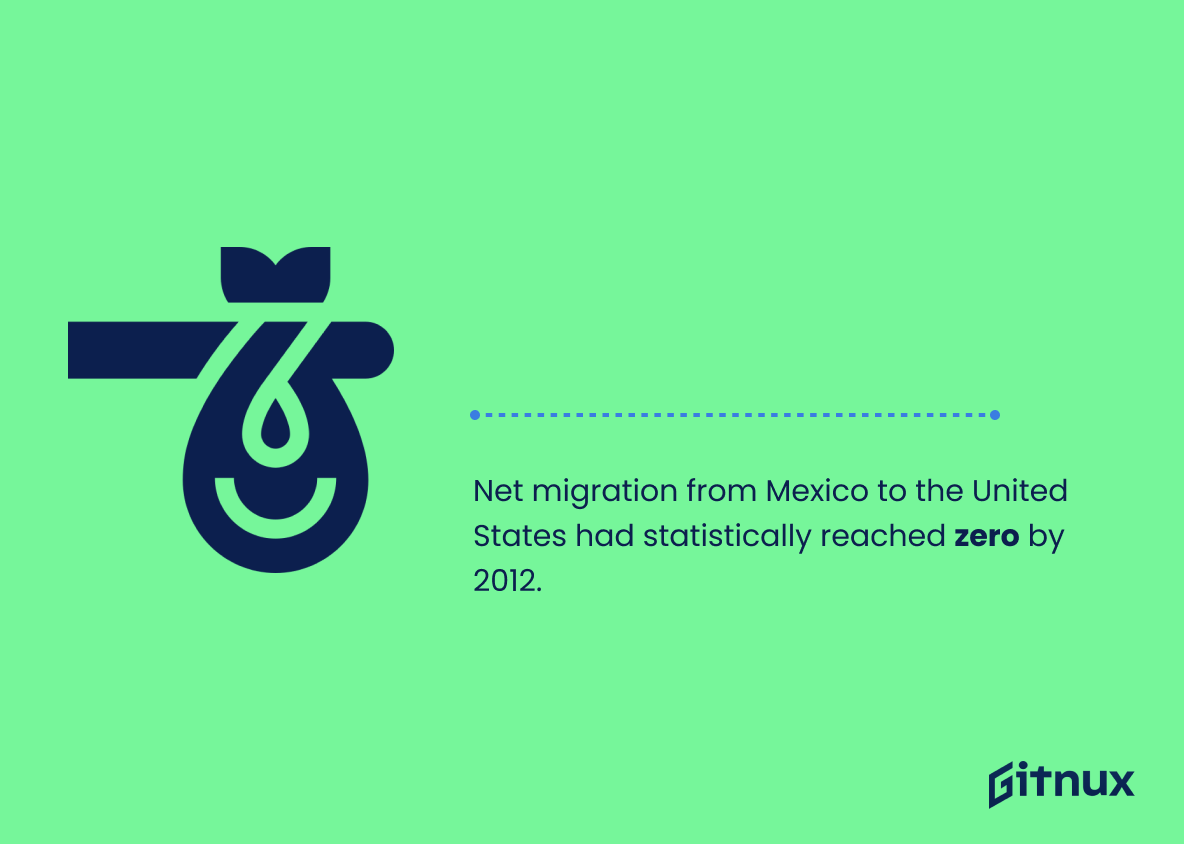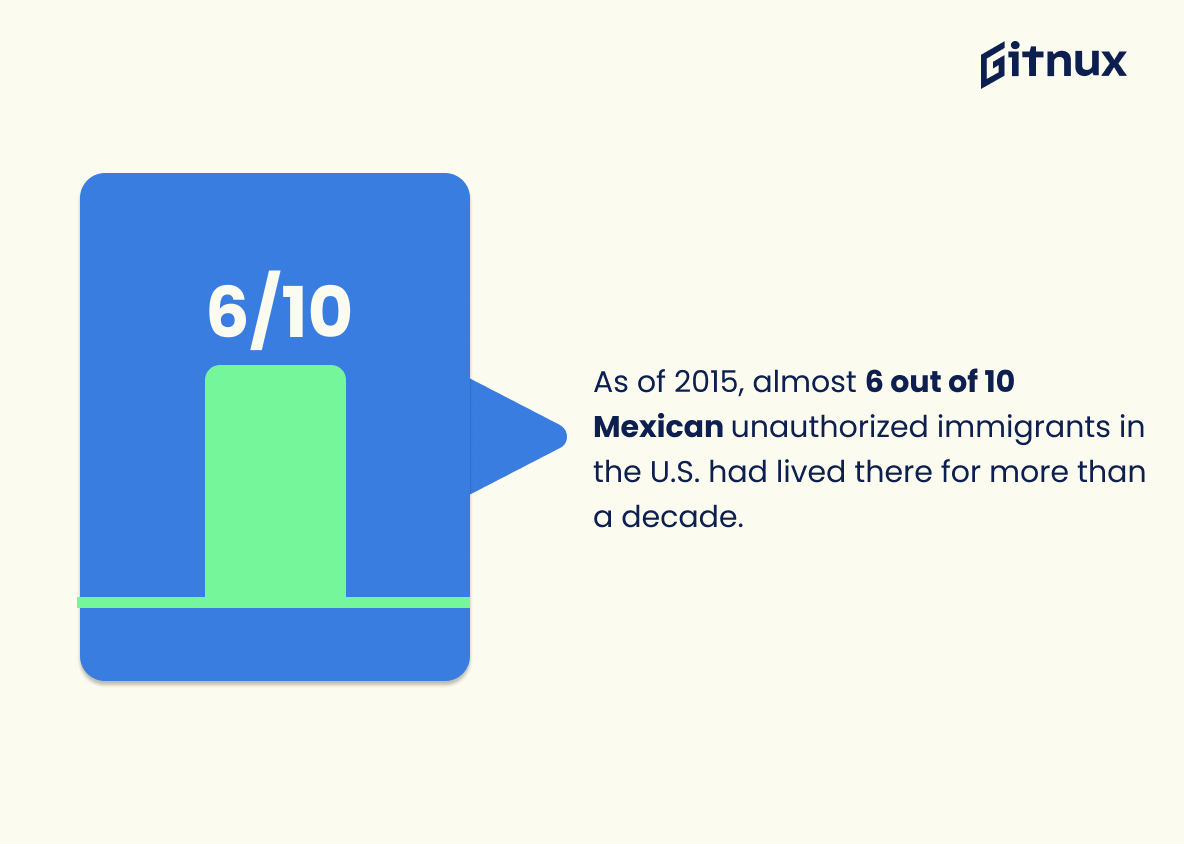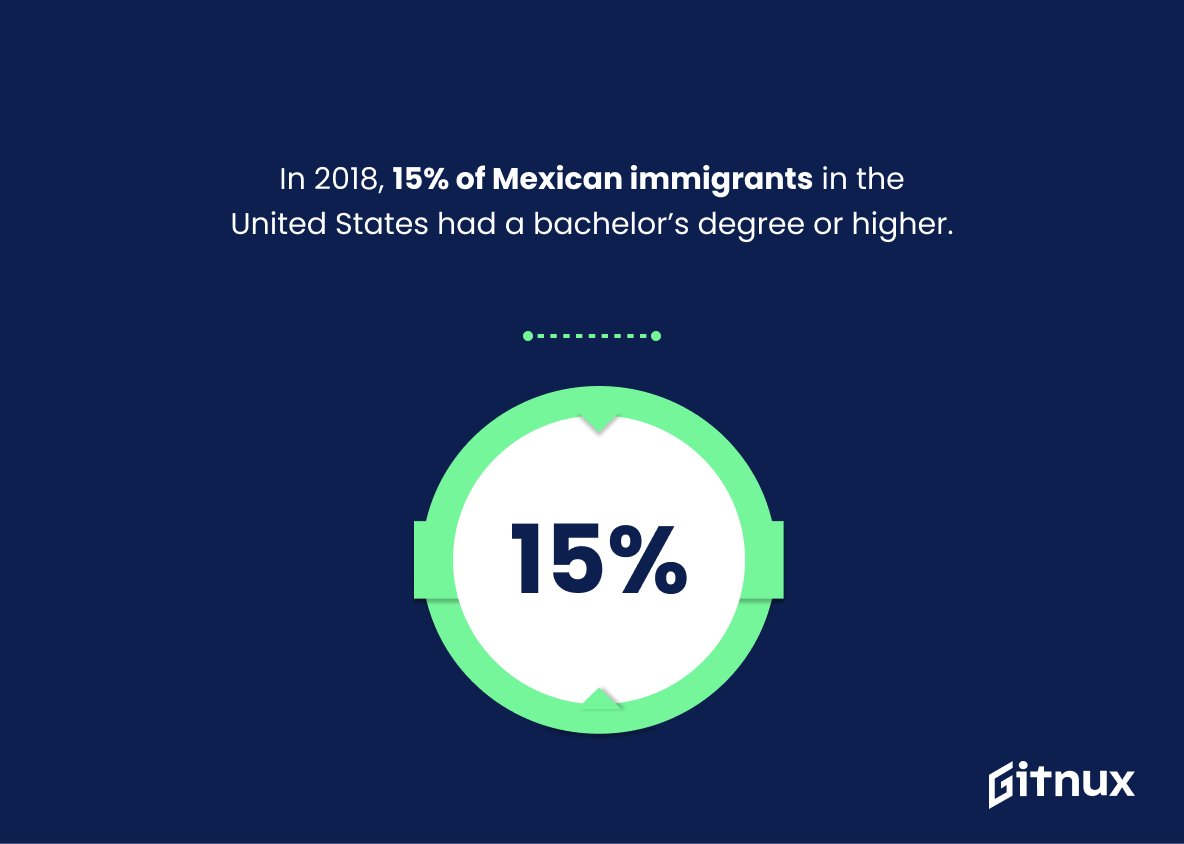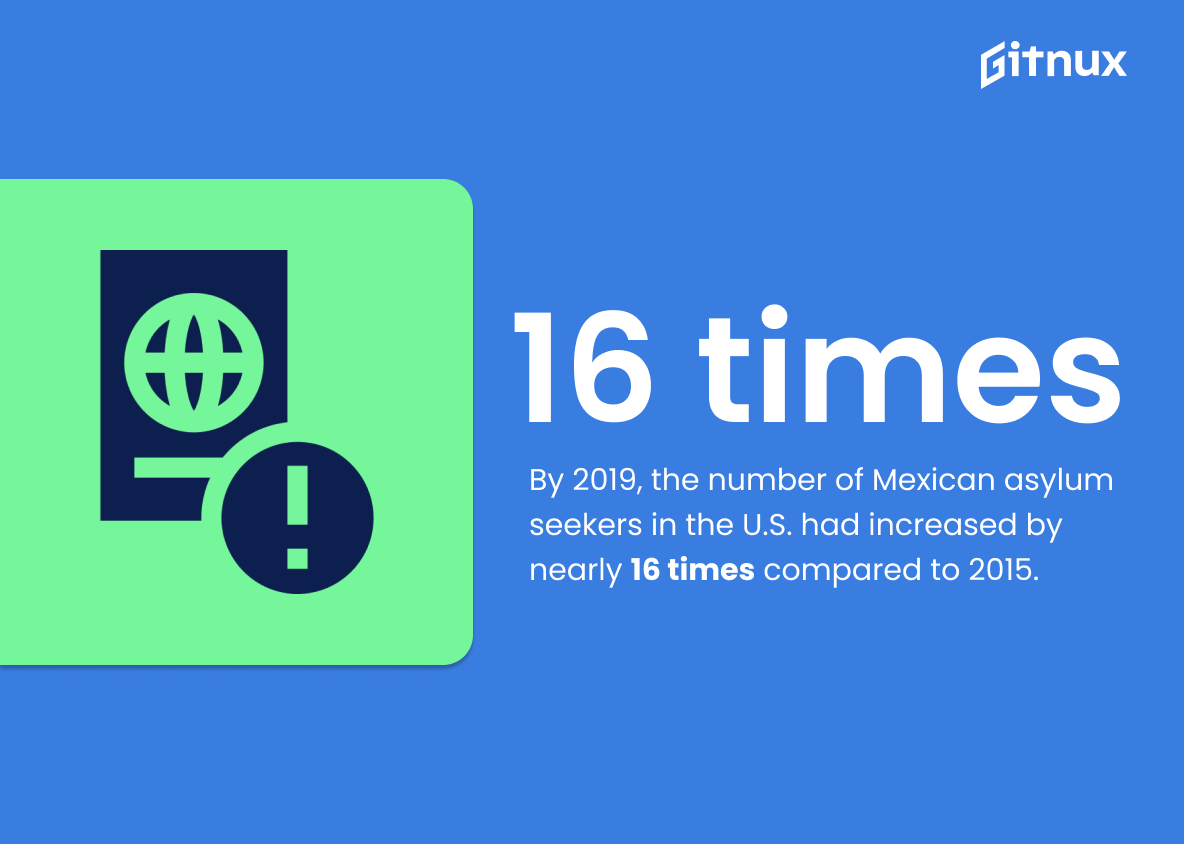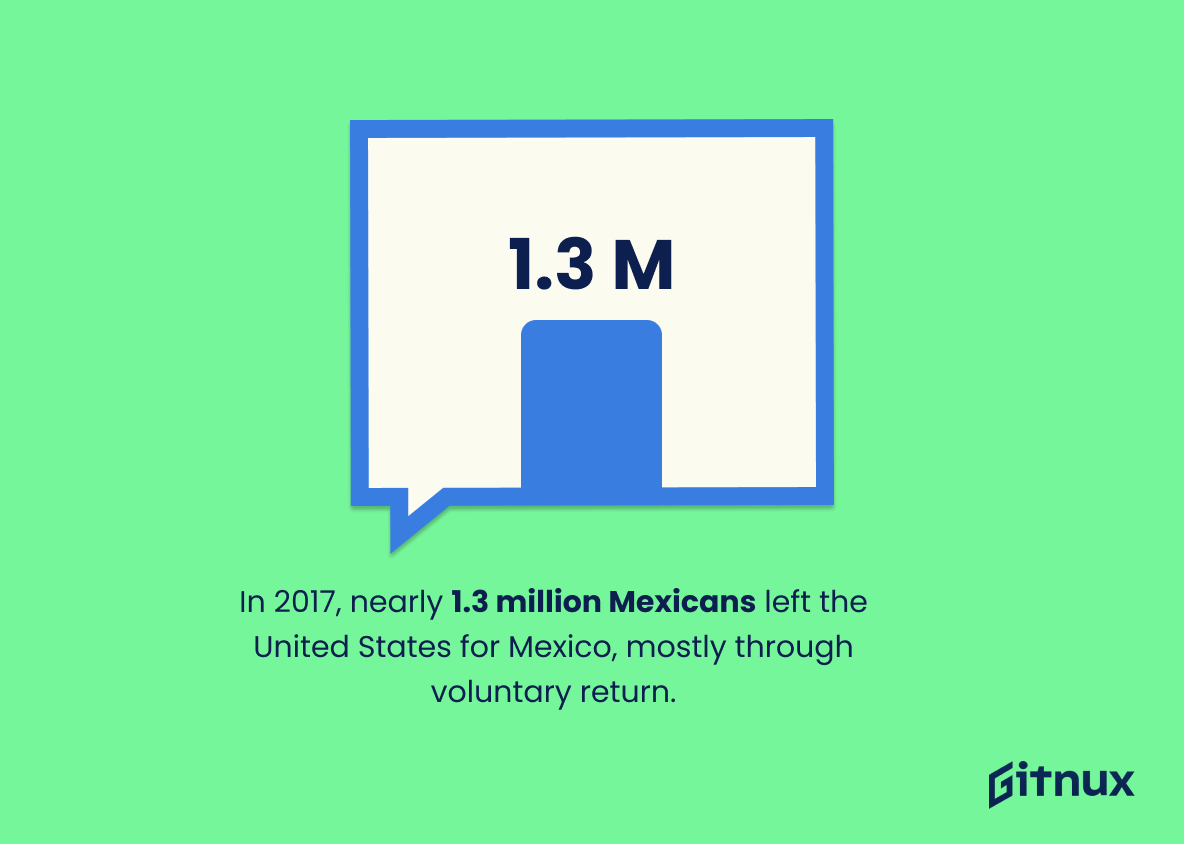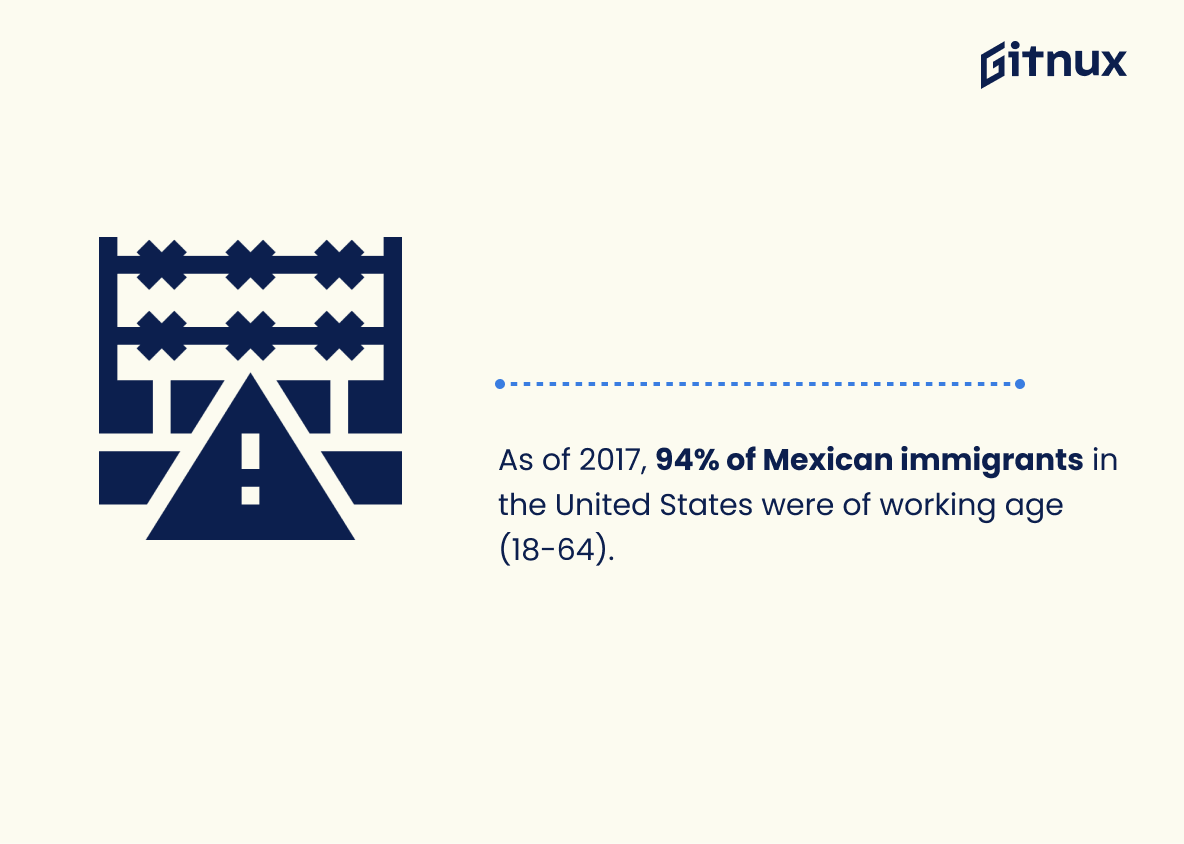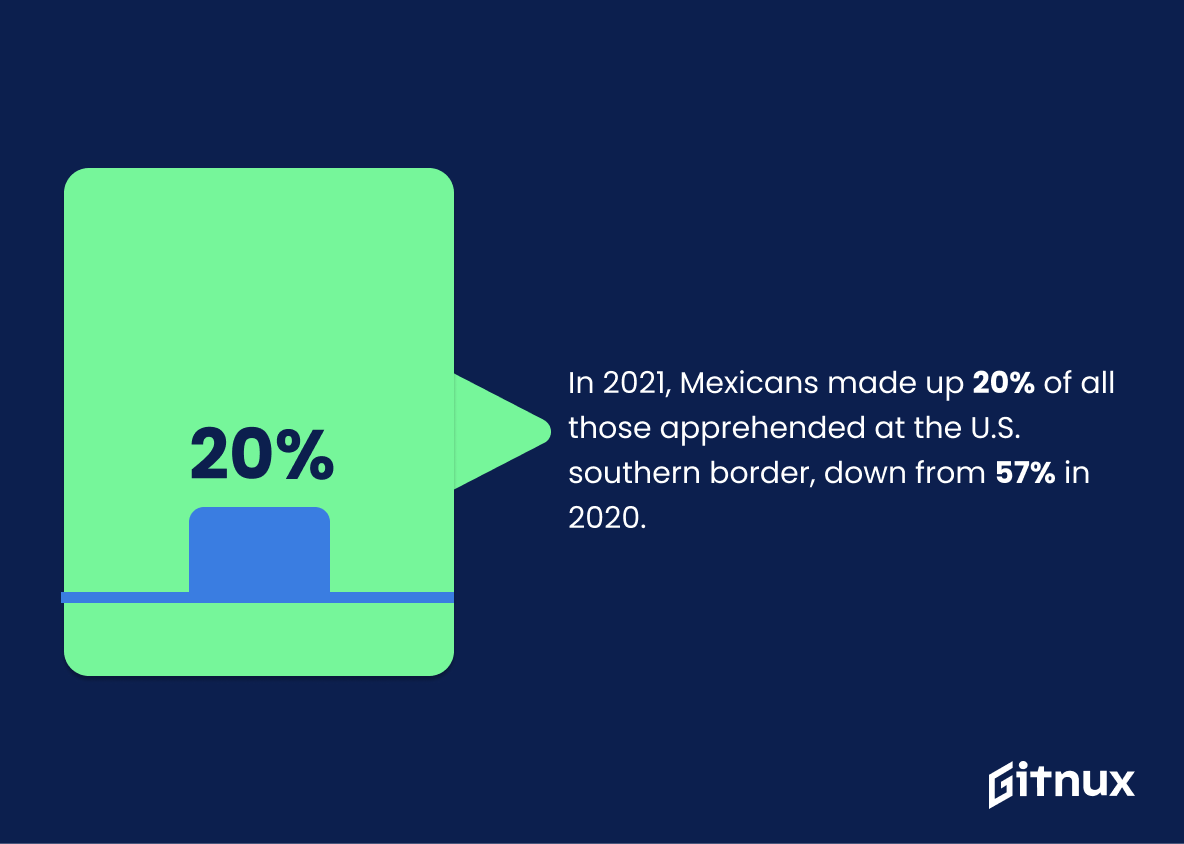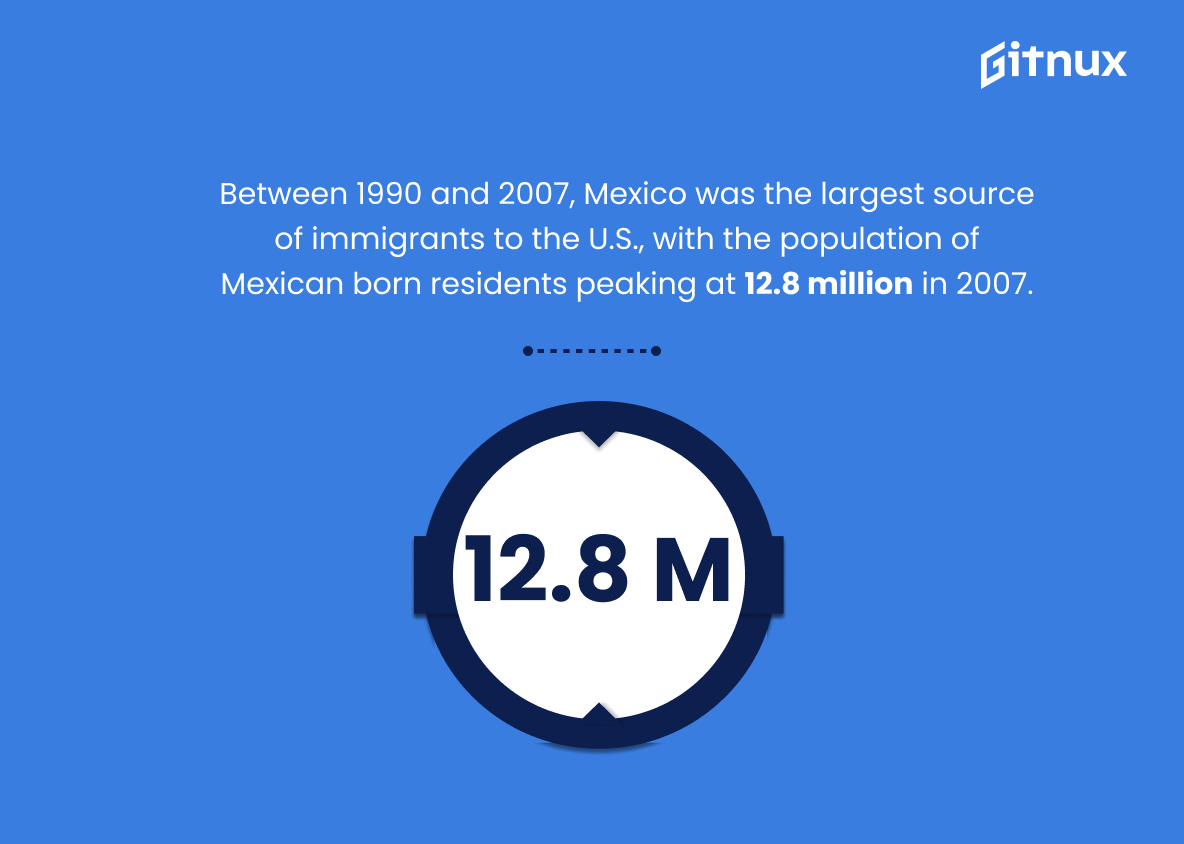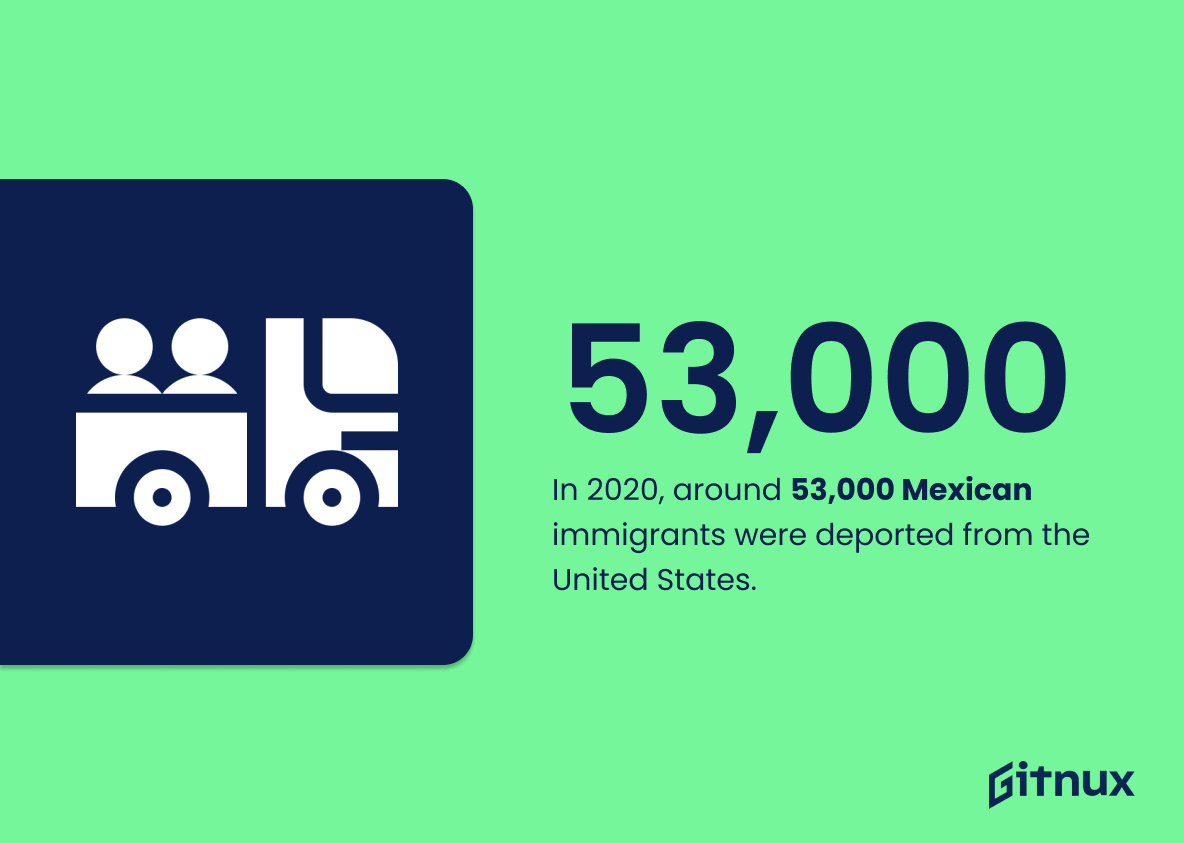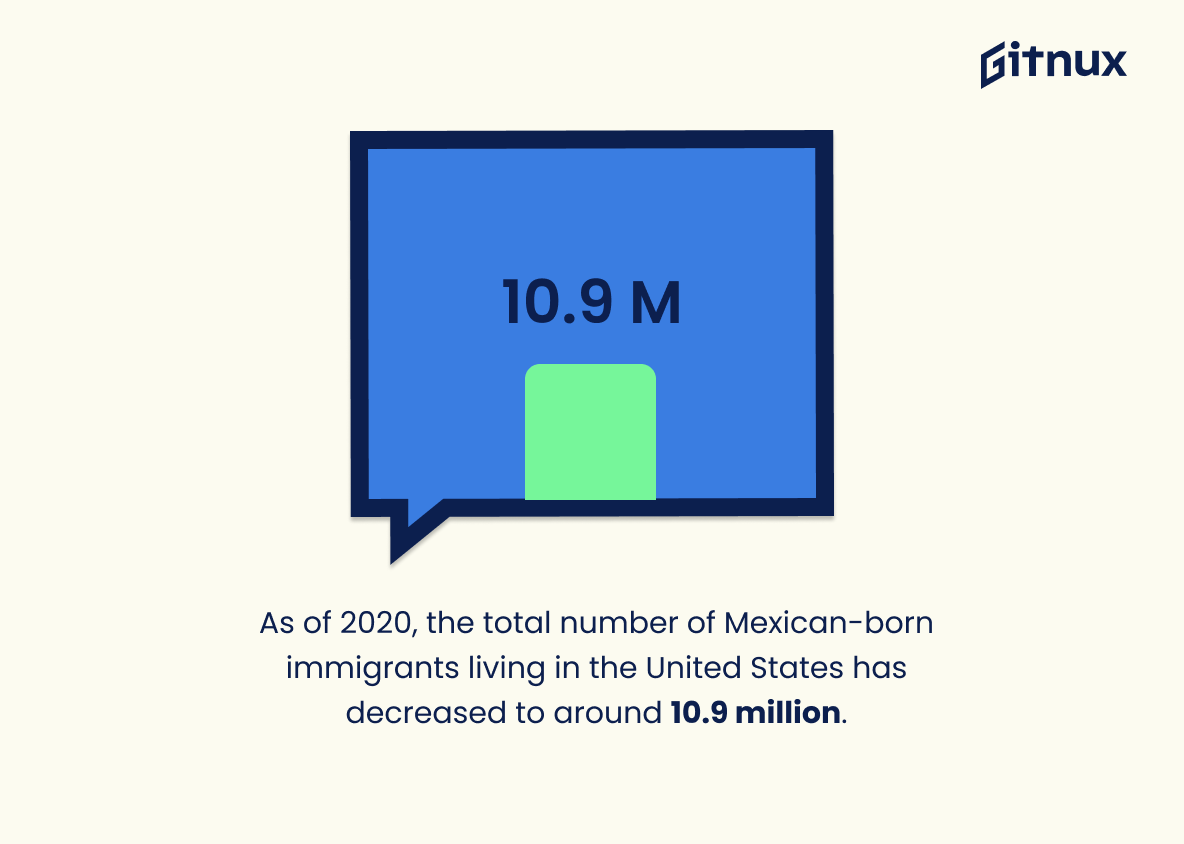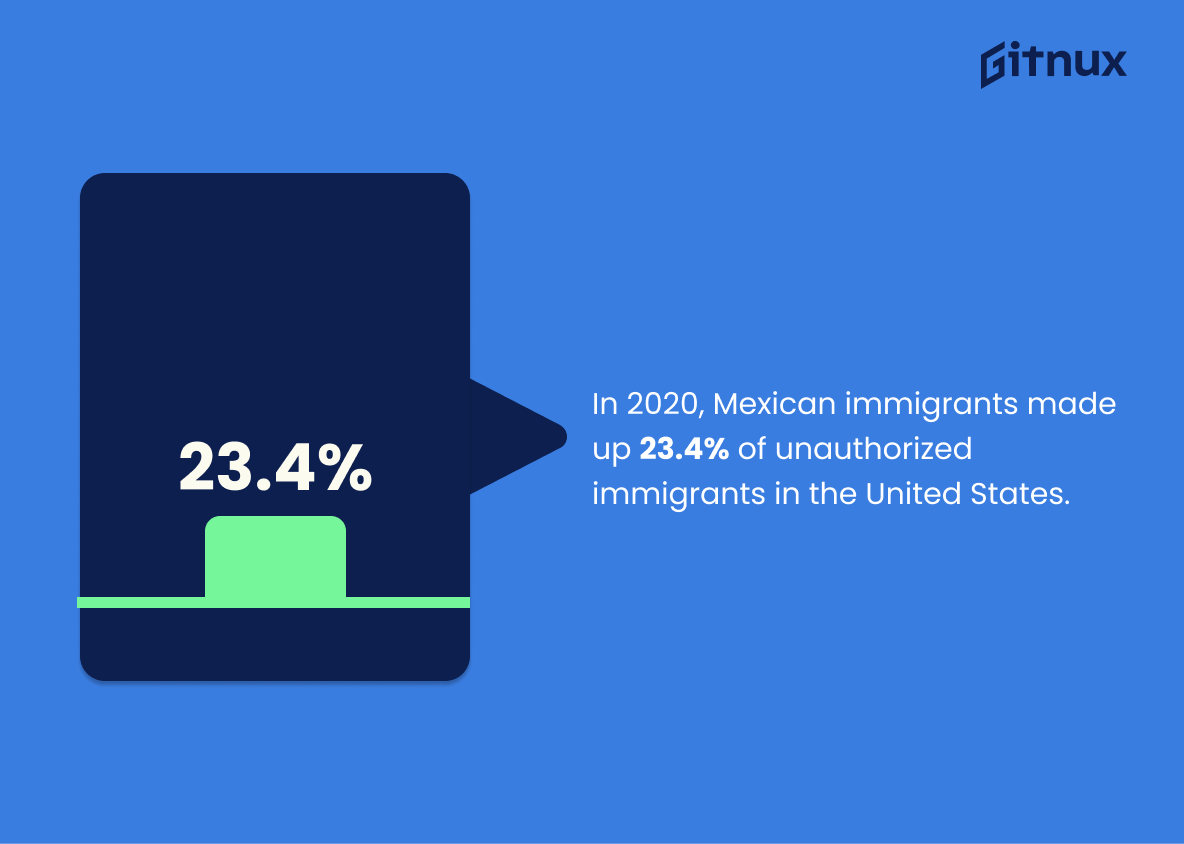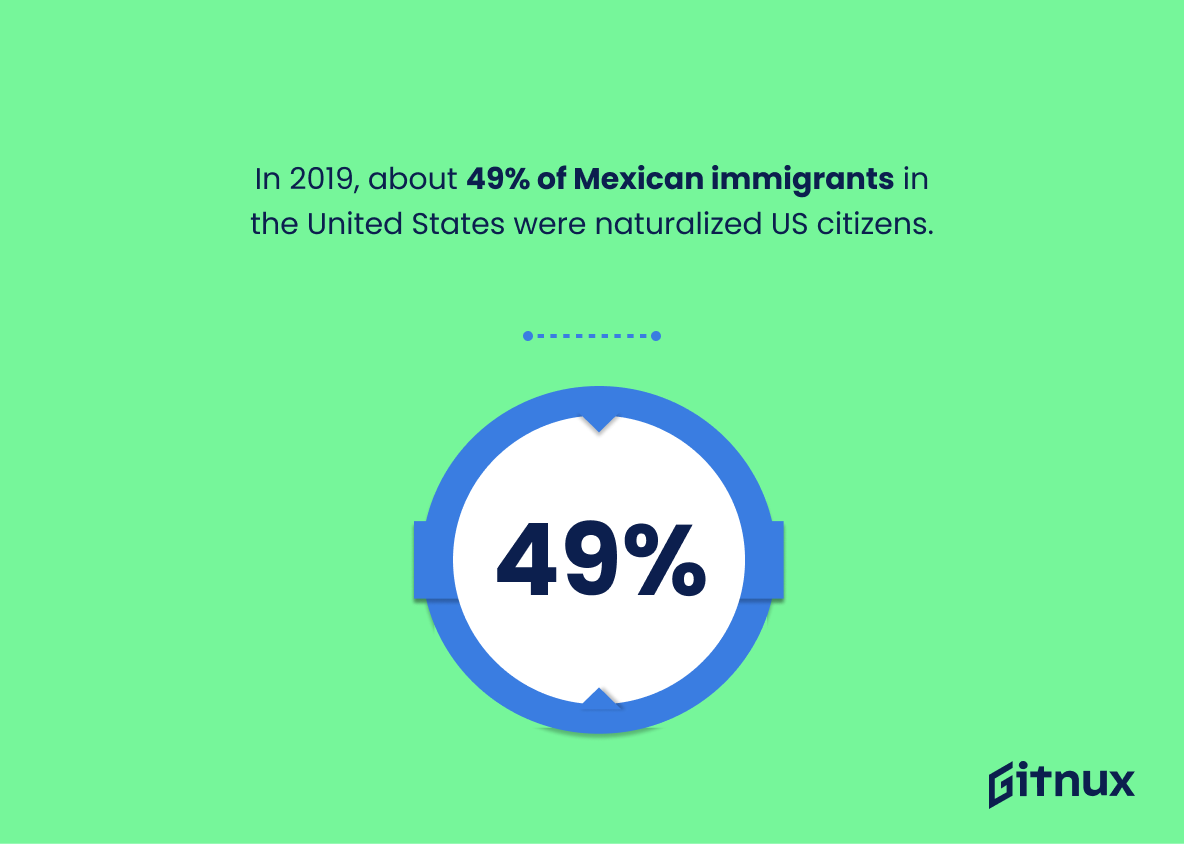Mexico has long been a major source of immigration to the United States. According to statistics from various sources, Mexico was the top country of origin for immigrants in 2018 with 11.2 million Mexican immigrants residing in the US and accounting for 15% of legal permanent residents admitted that year. In 2019, almost 6 out 10 unauthorized Mexican immigrants had lived there more than a decade while 94% were working age (18-64).
In 2020, 1.4 million people were apprehended at the U.S.-Mexico border; 41.9% were Mexicans and 53 thousand deported back to Mexico mostly through voluntary return programs as net migration from Mexico reached zero by 2012 due to increased enforcement measures taken by both countries since then . By 2021 non-Mexicans outnumbered Mexicans at 233k vs 108k respectively but still made up 20%.
Additionally, 40 percent of all temporary agricultural workers (H-2A visas) between 2010 and 2019 came from Mexico while India became the largest source country for international migrants surpassing it with 17%. Finally ,in 2018 15 %of Mexican Immigrants held bachelor’s degrees or higher compared 23 % among their US born counterparts .
These are just some facts about how much impact does immigration coming from our southern neighbor have on us today which we will explore further throughout this blog post series dedicated solely towards understanding current trends related to Immigration Statistics From Mexico To The United States Of America
Mexico Immigration Statistics Overview
Between 2007 and 2016, the number of Mexican unauthorized immigrants in the U.S. had decreased by 1.5 million or 22%.
This statistic is a powerful indicator of the changing landscape of Mexican immigration to the United States. It shows that in the span of nine years, the number of Mexican unauthorized immigrants has decreased significantly, by 1.5 million people. This is a significant drop of 22%, and it speaks to the changing dynamics of immigration from Mexico to the United States. This statistic is important to consider when discussing Mexico immigration statistics, as it provides a clear picture of the current state of affairs.
By 2020, more non-Mexicans than Mexicans were apprehended at the U.S. southern border (233,246 non-Mexicans and 108,614 Mexicans).
This statistic is a telling indication of the changing face of immigration to the United States. It shows that more people from other countries are attempting to cross the U.S. southern border than Mexicans, suggesting that the traditional pattern of Mexican immigration is shifting. This shift could have a significant impact on the U.S. immigration system and the way it deals with non-Mexican immigrants.
Net migration from Mexico to the United States had statistically reached zero by 2012.
The fact that net migration from Mexico to the United States had statistically reached zero by 2012 is a significant milestone in the history of Mexico’s immigration to the United States. It marks a dramatic shift in the trend of migration from Mexico to the United States, which had been steadily increasing for decades prior. This statistic is a testament to the success of policies and initiatives that have been implemented to reduce the number of undocumented immigrants entering the United States from Mexico. It also serves as a reminder of the importance of continuing to work towards a more secure and regulated immigration system.
As of 2015, almost 6 out of 10 Mexican unauthorized immigrants in the U.S. had lived there for more than a decade.
This statistic speaks volumes about the Mexican unauthorized immigrant population in the U.S. It shows that the majority of these immigrants have been living in the U.S. for a significant amount of time, indicating that they have become a part of the American fabric. This statistic is important to consider when discussing the impact of immigration on the U.S. economy and society.
In 2018, 15% of Mexican immigrants in the United States had a bachelor’s degree or higher.
This statistic is a testament to the educational achievements of Mexican immigrants in the United States. It shows that despite the challenges they face, they are still able to pursue higher education and gain valuable skills. This statistic is important in understanding the impact of Mexican immigrants on the US economy and society, as well as the potential for them to contribute to the growth of the country.
By 2019, the number of Mexican asylum seekers in the U.S. had increased by nearly 16 times compared to 2015.
This statistic is a stark reminder of the drastic increase in Mexican asylum seekers in the U.S. over the past few years. It highlights the urgency of the situation and the need for a comprehensive solution to the issue of Mexican immigration. It also serves as a reminder of the importance of understanding the underlying causes of this migration and the need to address them in order to ensure a safe and secure future for all.
In 2017, nearly 1.3 million Mexicans left the United States for Mexico, mostly through voluntary return.
This statistic is a telling indication of the current state of Mexican immigration to the United States. It shows that, despite the many challenges and obstacles that immigrants face, a significant number of Mexicans are still choosing to return to their home country. This speaks to the strength of the Mexican culture and the desire of many to remain connected to their homeland. It also highlights the importance of understanding the motivations and experiences of those who choose to leave the United States and return to Mexico.
As of 2017, 94% of Mexican immigrants in the United States were of working age (18-64).
This statistic is a powerful indicator of the potential economic impact of Mexican immigrants in the United States. With such a high percentage of Mexican immigrants of working age, it is clear that they are a valuable asset to the US economy, providing a large pool of potential workers and contributing to the growth of the country.
In 2021, Mexicans made up 20% of all those apprehended at the U.S. southern border, down from 57% in 2020.
This statistic is a telling indication of the changing dynamics of immigration at the U.S. southern border. It shows that the number of Mexicans apprehended at the border has decreased significantly in the past year, while the number of other nationalities has increased. This shift in immigration patterns is important to consider when discussing Mexico immigration statistics, as it provides insight into the current state of immigration in the region.
Between 1990 and 2007, Mexico was the largest source of immigrants to the U.S., with the population of Mexican born residents peaking at 12.8 million in 2007.
This statistic is a powerful indicator of the magnitude of Mexican immigration to the United States over the past two decades. It highlights the fact that Mexico has been the largest source of immigrants to the U.S. during this period, with the population of Mexican-born residents reaching its highest point in 2007. This information is essential to understanding the current state of Mexican immigration to the U.S. and the impact it has had on the country.
In 2020, around 53,000 Mexican immigrants were deported from the United States.
This statistic is a stark reminder of the harsh reality of immigration in the United States. It highlights the fact that despite the many efforts to protect and support immigrants, thousands of Mexican immigrants are still being deported from the United States each year. This statistic serves as a reminder of the need for continued advocacy and support for immigrants in the United States.
As of 2020, the total number of Mexican-born immigrants living in the United States has decreased to around 10.9 million.
This statistic is a telling indication of the current state of Mexican immigration to the United States. It reveals that the number of Mexican-born immigrants living in the US has decreased significantly since 2020, highlighting the impact of immigration policies and other factors on the Mexican immigrant population. This is an important point to consider when discussing Mexico immigration statistics, as it provides insight into the current state of the issue.
In 2018, Mexican immigrant men in the United States were three times more likely to be employed than their U.S.-born counterparts (71% vs. 23%).
This statistic is a powerful indicator of the value that Mexican immigrant men bring to the United States workforce. It demonstrates that despite the challenges they face, they are still able to find employment and contribute to the economy. This is an important reminder that immigrants are an integral part of the American economy and should be welcomed and supported.
In 2020, Mexican immigrants accounted for 23.4% of unauthorized immigrants living in the United States.
This statistic is a powerful reminder of the significant presence of Mexican immigrants in the United States. It highlights the importance of understanding the dynamics of Mexican immigration and the impact it has on the country. It also serves as a reminder of the need to create policies that are fair and just for all immigrants, regardless of their country of origin.
In 2019, about 49% of Mexican immigrants in the United States were naturalized US citizens.
This statistic is a powerful indicator of the success of Mexican immigrants in the United States. It shows that despite the challenges of immigration, a significant portion of Mexican immigrants have been able to become naturalized US citizens. This speaks to the resilience and determination of Mexican immigrants, and highlights the importance of providing them with the resources and support they need to succeed.
Between 2010 and 2019, nearly 40% of all temporary agricultural workers (H-2A visas) in the United States were from Mexico.
This statistic is a powerful indicator of the strong ties between Mexico and the United States when it comes to agricultural labor. It speaks to the reliance of the US agricultural industry on Mexican workers, and the importance of Mexico as a source of labor for the US. It also highlights the importance of immigration reform in the US, as the H-2A visa program is often seen as a way to provide legal pathways for Mexican workers to enter the US. This statistic is a reminder of the need for a comprehensive immigration policy that takes into account the needs of both countries.
In 2020, of the 1,448,664 immigrants apprehended at the US-Mexico border, 41.9% were Mexican.
This statistic is a powerful indicator of the magnitude of Mexican immigration to the United States. It demonstrates that the majority of immigrants apprehended at the US-Mexico border are Mexican, highlighting the importance of Mexico as a source of immigration to the US. This statistic is essential to understanding the current state of Mexico immigration and the challenges that come with it.
Conclusion
The statistics presented in this blog post demonstrate the complexity of Mexico’s immigration to the United States. Despite a decrease in Mexican unauthorized immigrants since 2007, Mexicans remain one of the largest groups of foreign-born individuals living and working in America today. In 2018, they accounted for 15% of all legal permanent residents admitted into the country and 49% were naturalized US citizens by 2019.
Additionally, 41.9% of those apprehended at U.S.-Mexico border crossings were from Mexico as recently as 2020 – making them still one of the top countries sending migrants to America despite India surpassing them globally that same year with 17.5%. These figures show how important it is for both nations to continue collaborating on migration policies that are beneficial for everyone involved while also respecting human rights along every step taken towards achieving these goals
References
0. – https://www.www.pewhispanic.org
1. – https://www.cis.org
2. – https://www.www.migrationpolicy.org
3. – https://www.www.dhs.gov
4. – https://www.www.pewresearch.org
5. – https://www.www.cbp.gov
6. – https://www.www.ice.gov
7. – https://www.www.uscis.gov
